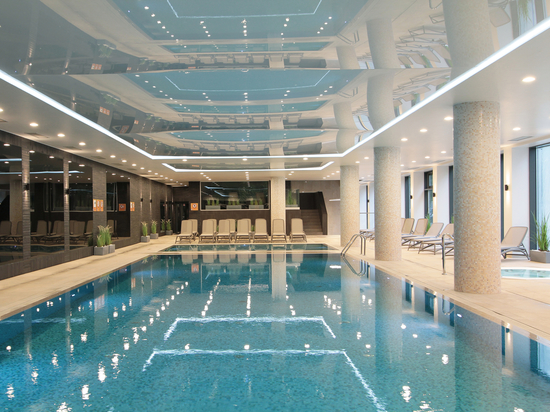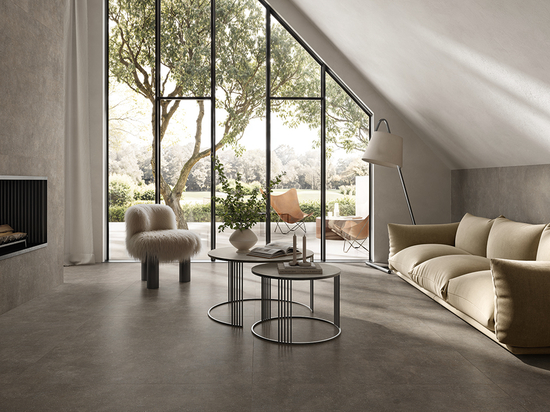
#Inspiration
The Potteries Museum and Art Gallery: façade cladding in porcelain stoneware
The porcelain stoneware tiles from the Marte Botticino collection were used to clad the entire ventilated façades of the Spitfire Gallery, an extension of the Potteries Museum and Art Gallery.
The Potteries Museum & Art Gallery is part of the Stoke-on-Trent Museums Service, founded in 1911 by the Federation of the six towns of Stoke-on-Trent, an area in Staffordshire with a rich industrial history known as ‘The Potteries’. The Potteries Museum Art Gallery is home to a varied collection of over one million objects, including a world-famous collection of pottery comprising more than 5000 pieces. Because Stoke-on-Trent is the core of the English ceramic pottery industry, the exhibits in the museum offer an account of the history of production and design in the sector, including works by leading manufacturers from the 18th and 19th centuries, such as Wedgwood, Spode and Minton.
Officially opened in September 2021, this extension of the Potteries Museum & Art Gallery was given the name Spitfire Gallery as a tribute to the RW388 Spitfire fighter plane. As well as being a symbol of top-flight design and engineering, the plan is also emblematic of the link between Stoke-on-Trent and the designer of the Spitfire, Reginald Joseph Mitchell, who was born in Staffordshire and completed his studies there.
The new museum area was designed by the architect Lisa Deering of Glancy Nicholls Architects, and the material chosen for the façade cladding was porcelain stoneware. This durable, resistant material is perfectly consistent with Stoke’s industrial heritage, the nature of the museum and the other elements of the building envelope.
The Spitfire Gallery features 471 square metres of ventilated façades, entirely covered with 60x120 cm porcelain stoneware tiles from the Marte collection, in the colour Botticino. The detailed design, involving a group of experts, allowed for perfect synergy between the porcelain stoneware tiles and the structure, even at the most complex points of the ventilated façade, featuring sloping surfaces and partitions.
The Potteries Museum and Art Gallery has been engraved on eight ceramic tiles using the precision water jet technique.
Façade cladding applications using Casalgrande Padana ceramic tiles
Innovative cladding systems that allow for the installation of ceramic materials with highly functional technical features, as well as enhancing the hygrothermal performance of the walls. Casalgrande Padana is able to provide solutions for ventilated walls, façade cladding with glued ceramic tiles and insulation systems with thin tiles. Casalgrande Padana’s wide range of large porcelain stoneware tiles allows designers to unleash their architectural creativity for the development of large vertical, sloping or curved surfaces.
The use of Casalgrande Padana porcelain stoneware tiles on the exterior of the building offers protection from inclement weather and pollution, with significant advantages in terms of thermal and acoustic insulation. It also protects the masonry structure, saves energy, eliminates thermal bridges and surface condensation, as well as enhancing the appearance of the façade and maintaining its aesthetic and technical characteristics.
Thanks to the Bios Self-Cleaning® technology, the ceramic tiles used for façade cladding and ventilated building envelopes have excellent self-cleaning properties and are able to reduce NOx gases (nitrogen oxides and mixtures, among the main air pollutants in urban areas).
Specifically, Bios Self-Cleaning® is able to combine the renowned aesthetic characteristics and technical performance of porcelain stoneware tiles with the ability to reduce cleaning and maintenance, guaranteeing significant savings while maintaining the quality and appearance of buildings.
Bios Self-Cleaning® is able to guarantee excellent performance, especially for façade cladding, with excellent photo-catalytic properties that when triggered by light, can break down the organic substances and pollutants on the tile surface, for a self-cleaning, air-purifying effect. It also has superhydrophilic properties that boost its self-cleaning capacity, and antibacterial characteristics triggered by the effect of the UV rays in sunlight. The reaction triggered by the light on the tile surface treated is able to produce active oxygen and break down bacteria.
The Bios Self-Cleaning® treatment’s ability to eliminate nitrogen oxides makes a significant contribution to improving air quality in urban areas: a 150 m2 façade with the Bios Self-Cleaning® treatment purifies the air as much as a wooded area the size of a football pitch and eliminates the nitrogen oxides emitted by 11 cars in one full day.











